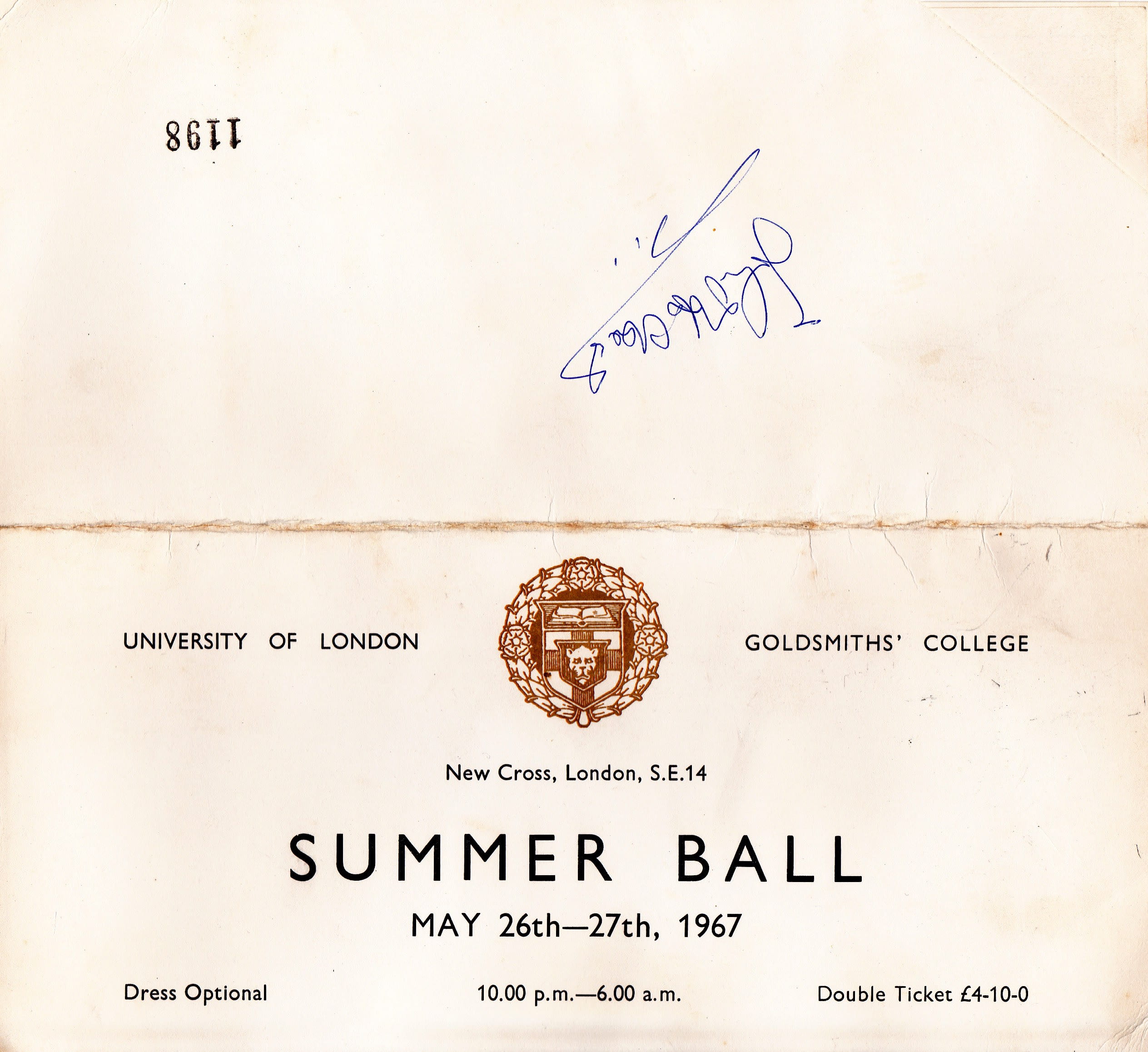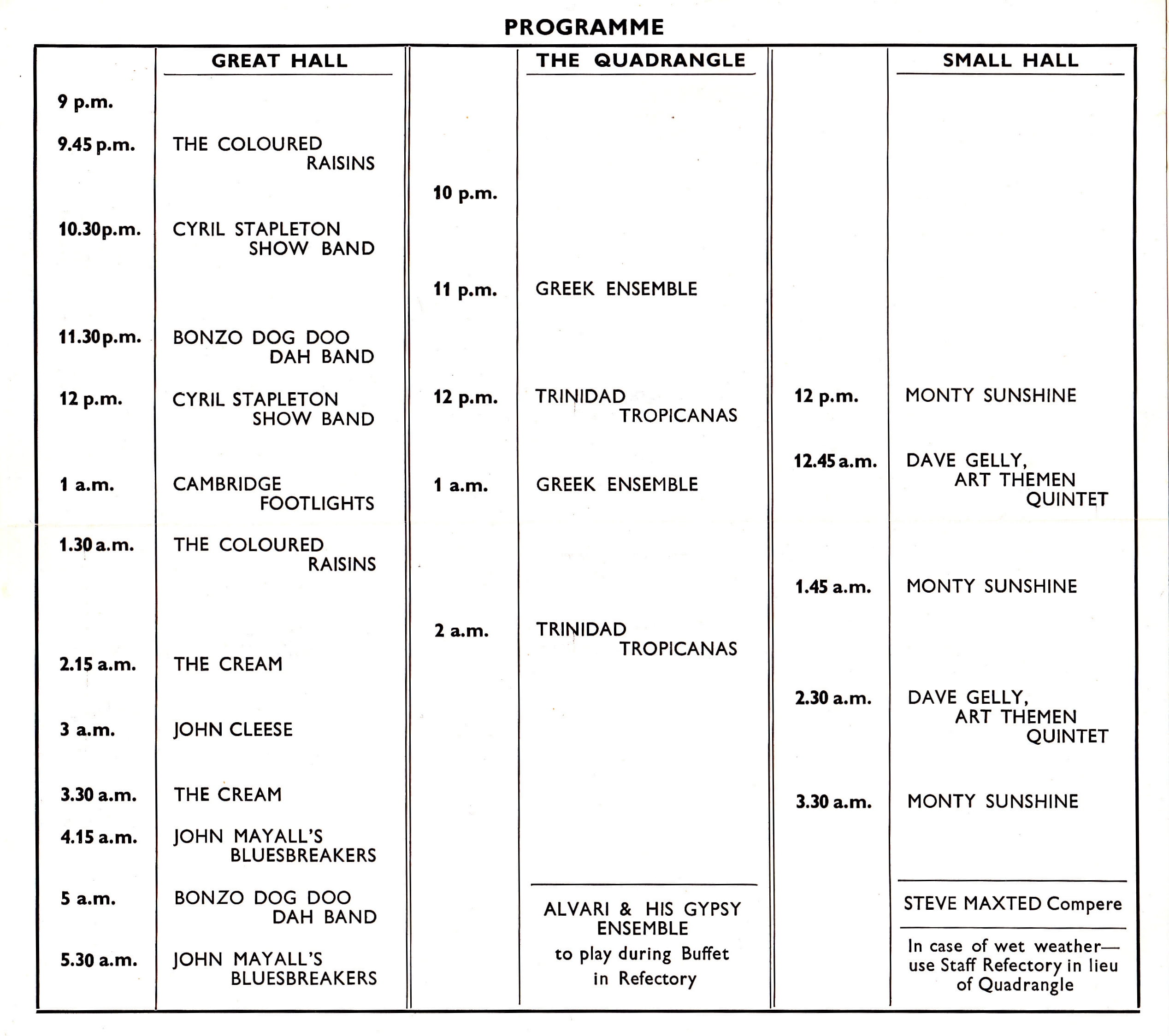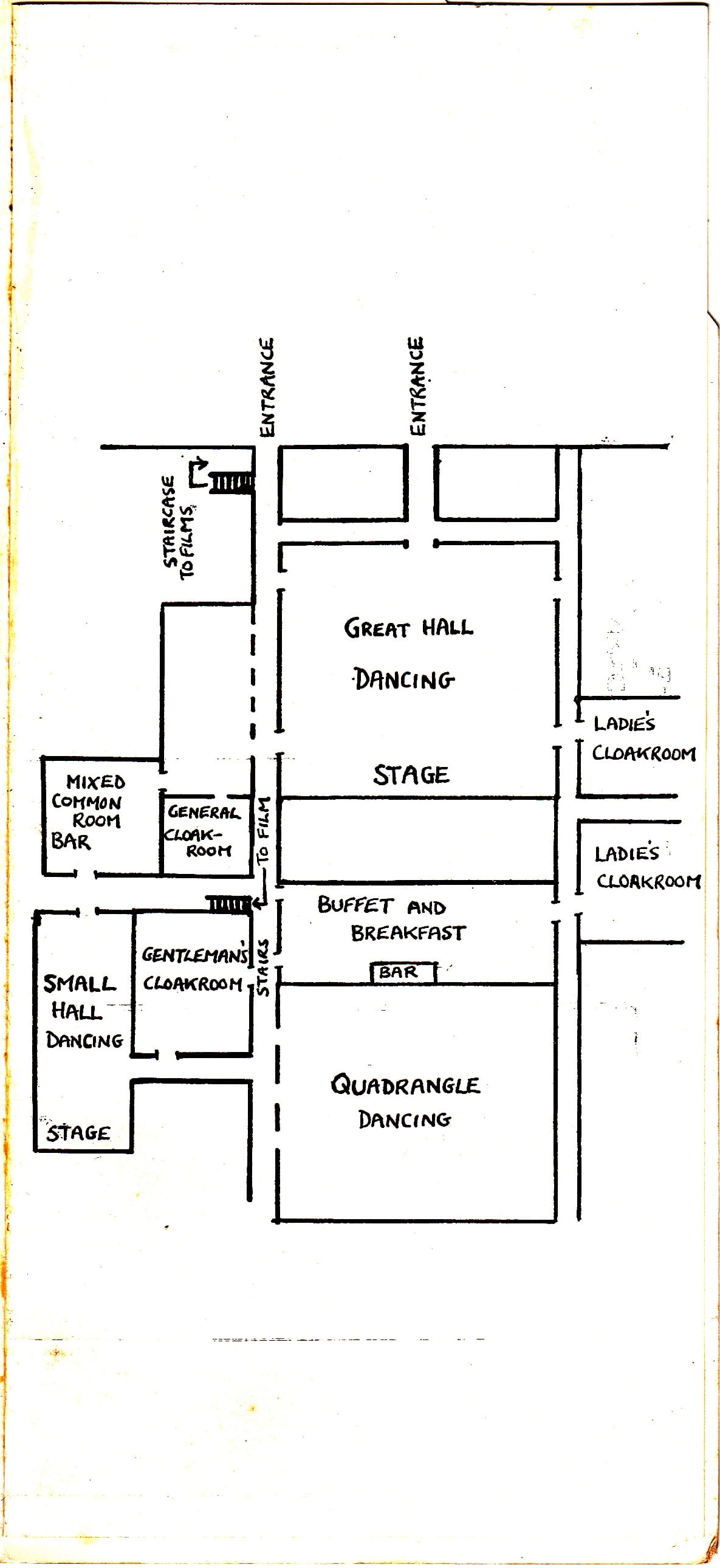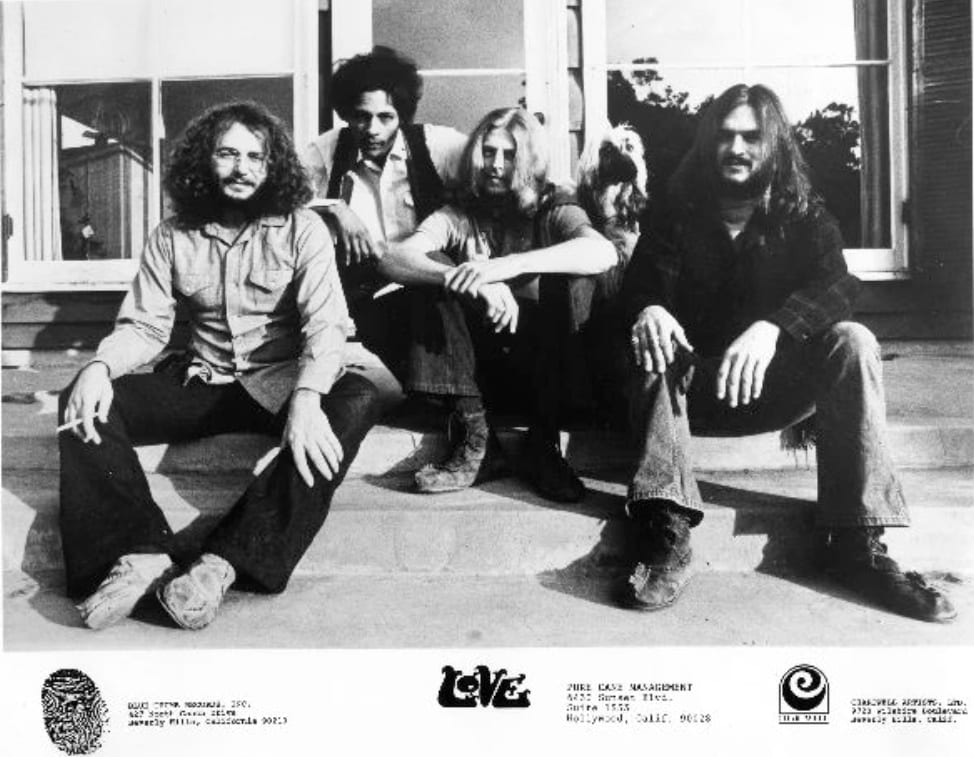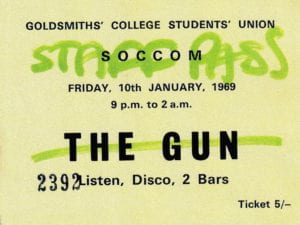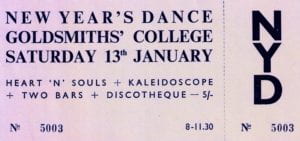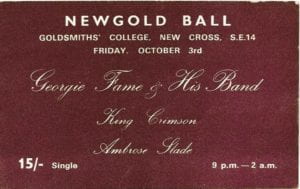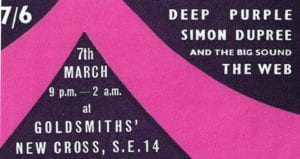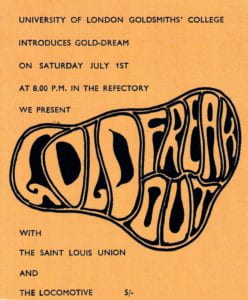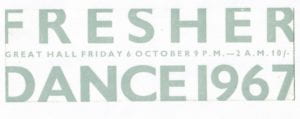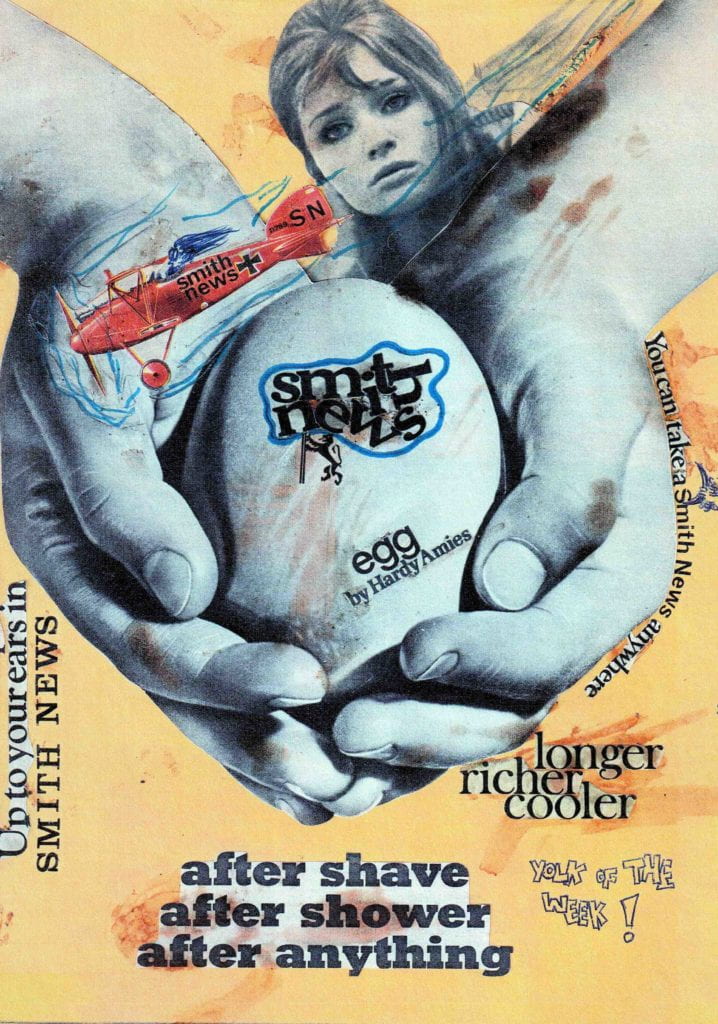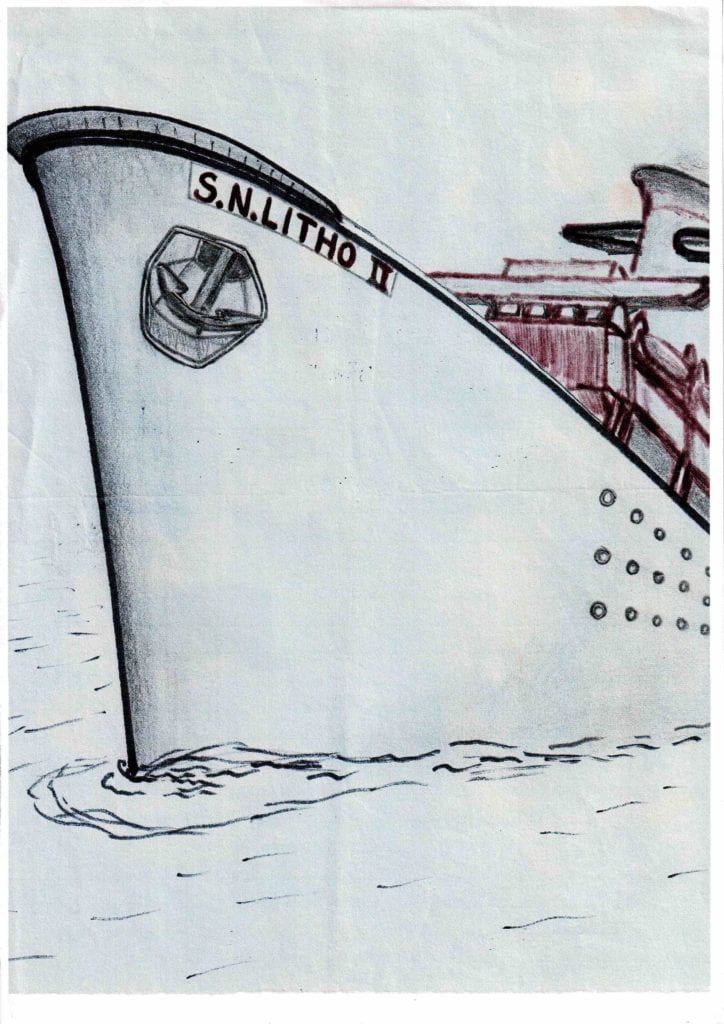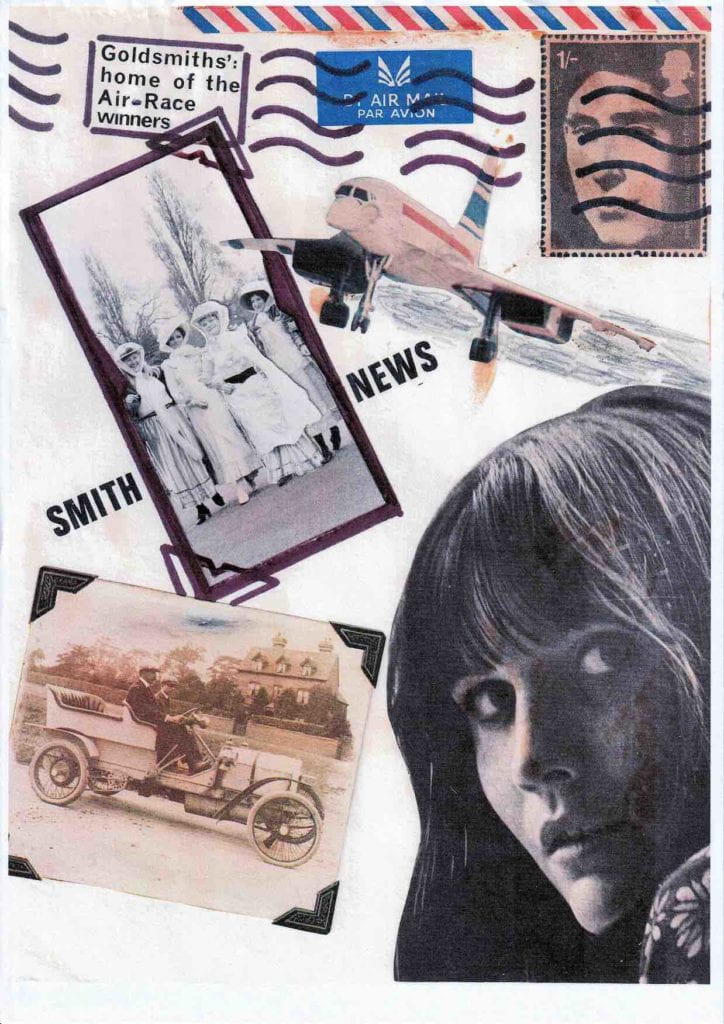
The top of the psychedelic poster design for Golddream at Goldsmiths’ College between June 26th and July 1st 1969. Image: Poster donated to Goldsmiths Archives by Greg Conway.
In 1969 Goldsmiths’ College student union organised a third Golddream summer festival of music and arts.
This festival was going to last an entire week and one of the organisers, the late manager of the Sex Pistols, Malcolm McLaren (then known as Malcolm Edwards) wanted it to be free and open to everyone.
Some of the world’s leading performers filled the campus performing rock music, folk music, poetry and readings.
The poetry readings included a performance by the respected film actor of the period, David Hemmings, who starred in Michelangelo Antonioni’s Blowup in 1966 in which Goldsmiths’ College students took part as extras; particularly in the scenes filmed in Maryon Park, Charlton.
There was also a political speech from the black revolutionary and civil rights activist of the 1960s Michael X who was under surveillance by Britain’s intelligence services.
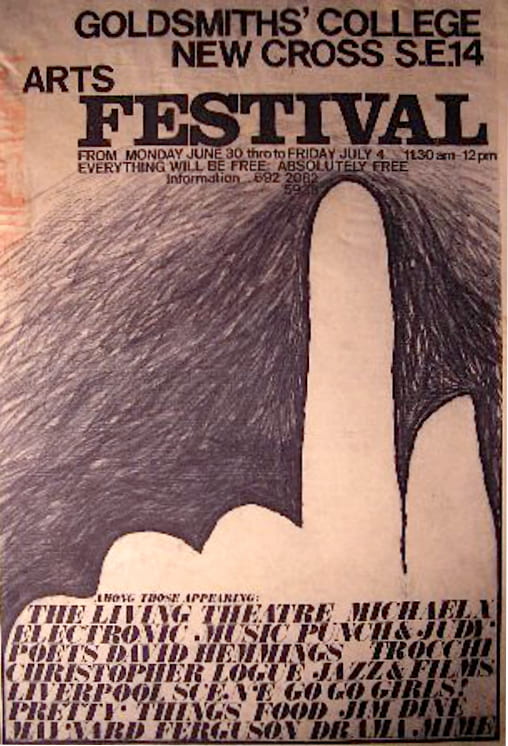
The first poster announcing the Goldsmiths’ College Arts Festival of 1969 being ‘Absolutely Free’. Image: Dave Riddle
He was born with the name Michael de Freitas and also known as Michael Abdul Malik and Abdul Malik.
His controversial life ended with his execution in Port of Spain, the capital of Trinidad and Tobago, in 1975 after being convicted of murdering a member of his political commune.
Many thousands of mainly young people played, partied, danced, and ‘rock’n rolled’ for seven days and seven nights.
The sound of the performance of the progressive rock group King Crimson could be heard many miles away with massive mega-watt speakers facing out from the College main building onto the back field.
One of the organisers, the then Student union social secretary Dave Riddle, has loaned his unique collection of event posters and memories from the period for a special exhibition in the Kingsway corridor running from early March to April 13th 2019.
Dave recalls:
“King Crimson’s performance was spectacular at dusk with Pete Sinfield’s light show and strobe lighting effects creating the illusion of the disintegration of the rear wall of the building.”
The legendary folk musician Gordon Giltrap was an active member of the College’s Folk Club and took part in the festival- an experience he has never forgotten:
“Those Goldsmiths days hold very fond memories as I was slowly making a name for myself on the London folk/blues scene. I well remember being a part of the college Arts Festival and even being featured in the local paper (I still have the clipping) and witnessing a spellbinding performance by an amazing new band called King Crimson. Another band playing at the festival was Ambrose Slade later to become Slade. Magical Days indeed! A few close friendships were made during that time, and one in particular remains to this day (page 9 The Way We Were).”
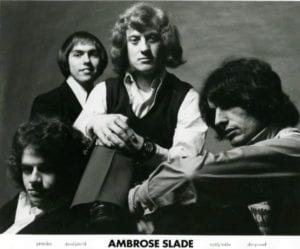
Ambrose Slade publicity photograph sent to Goldsmiths’ College Student union social secretary Dave Riddle. Image: Dave Riddle.
The exhibition is combined with the documentary photography of a Goldsmiths’ student from the late 1960s, Dr. David Bracher.
In 2011 he authored and published a remarkable photographic and documentary testament to the culture and social life of this period in the book The Way We Were which is being republished to coincide with the Golddream exhibition and 50 year celebrations of 1969.
In the book Gordon Giltrap remembers David Bracher as ‘a hip, good looking student who took me under his particular wing of friendship and would chauffeur me to various gigs and rehearsals in and around London in his old Austin Seven with my guitar poking out through the roof!
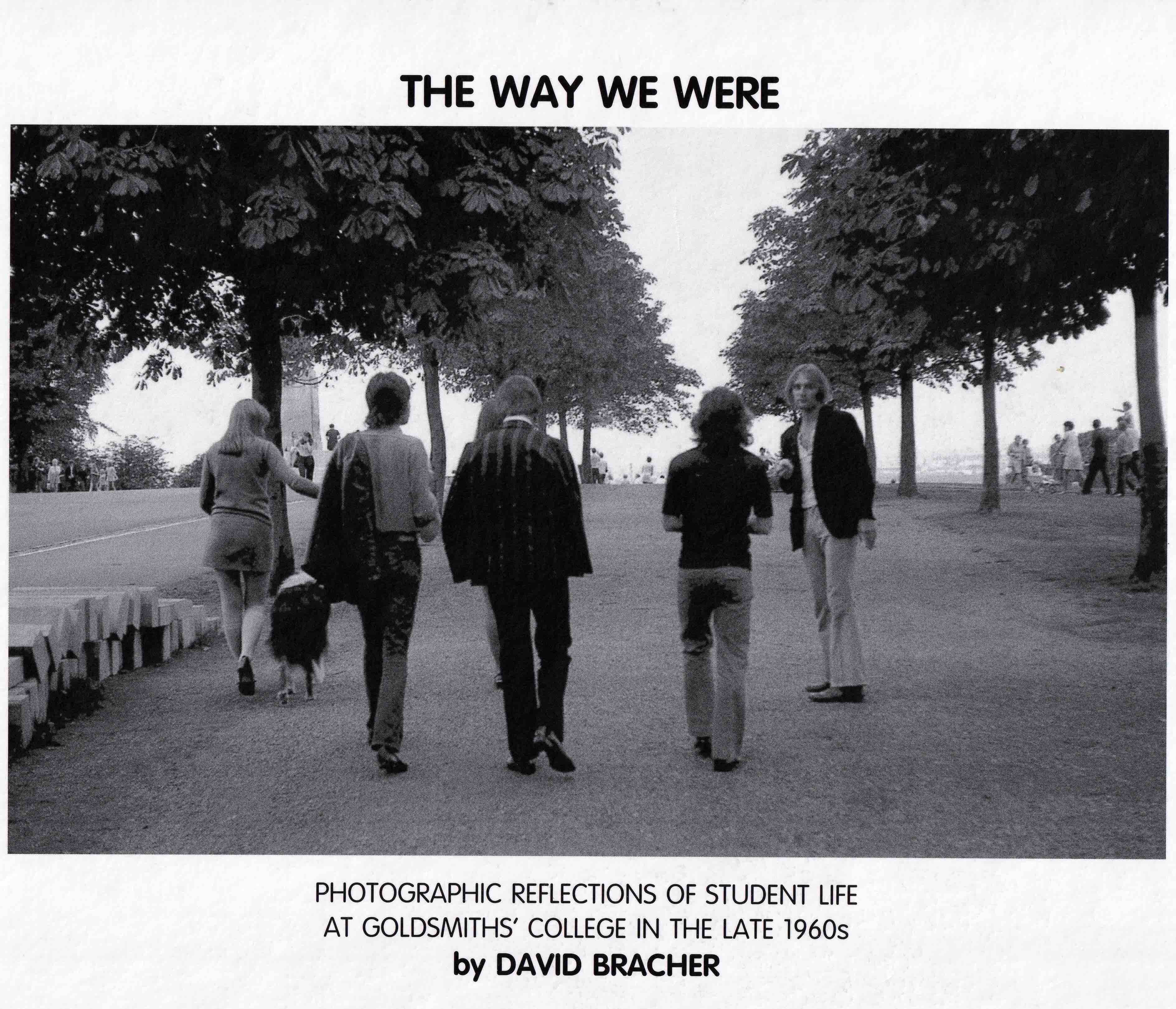
Cover of ‘The Way We Were’ being republished in 2019. Image: David Bracher
Other College alumni who were there and part of the unique music, artistic and student culture from this decade have contributed their memories and memorabilia.
In particular, Goldsmiths Student Union President in 1969-70, Russell Profitt, who remembers Cream (Eric Clapton, Jack Bruce and Ginger Baker) and John Cleese and the Cambridge Footlights performing in the Great Hall in the early hours of the morning during a May Summer Ball in 1967.
The drummer/percussionist was the very striking red-headed and charismatic Ginger Baker, who was Lewisham born and bred, and has always had a reputation for a temperament that could be described in the politest terms as ’emphatic’.
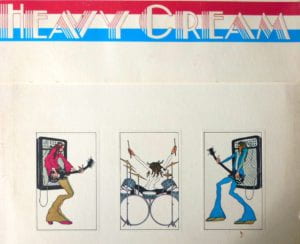
The cover for the double album Heavy Cream released in 1968.
When he was setting up the instruments on the stage of the Great Hall he would meet the equally formidable College Superintendent, Len Lusted, who had served with distinction during the Second World War and reached the rank of Captain in the British Army.
A remarkable feature of the Goldsmiths music days and performances would be the fact that they were often all evening and through the night events with breakfast being provided in the morning in the College refectory.
One of the exhibits in the Goldsmiths exhibition is a programme of the 1967 May Ball showing that Cream performed their two hour set between 2.15 and 4.15 a.m. The programme is personally autographed by the comedian John Cleese (later of Monty Python fame).
He performed for The Cream’s half hour interval at 3 a.m, who were then followed at 4.30 a.m. by John Mayall’s Bluesbreakers.
A highly regarded reggae band of the period, The Coloured Raisins and steel band Trinidad Tropicanoes also performed.
‘Alvari and his Gypsy Ensemble’ were booked to perform during the midnight buffet in the refectory.
These events occupied multiple sites on the College campus including the Quadrangle outside the Refectory and the Small Hall (which is currently the site of the Curzon Cinema).
The Small Hall was the venue between midnight and 3.30 a.m. for suitably Sixties sounding groups ‘Monty Sunshine’ and ‘Dave Gelly Art Themen Quintet.’
The Goldsmiths Student Union’s handbook for the following year included three photographs from the Summer Ball of 1967 featuring Cyril Stapleton and his band, Monty Sunshine and his band, and John Mayall’s Bluesbreakers.
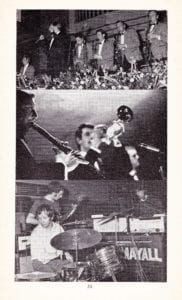
From top to bottom: Cyril Stapleton, Monty Sunshine and their bands, and John Mayall’s Bluesbreakers. Image: Goldsmiths Archives.
It was reported:
“The major idea behind the Summer Ball, the highlight of the year’s social events, was to offer as diverse a choice of entertainment as was possible between 10 p.m. and 6 a.m. Apart from three bars open till 4 a.m. and a buffet supper and breakfast, the entertainment ranged from a gypsy ensemble in the refectory, through a steel band and a Greek band in the open air quadrangle. Monty Sunshine’s and Art Themen’s Jazz Bands in the Small Hall, to the centre of the Ball in the Great Hall, where during the night could be heard Cyril Stapleton and his band, The Cream, John Mayall’s Bluesbreakers, The Bonzo Dog Doo-Dah Band, The Coloured Raisins as well as a cabaret in the form of John Cleese and the Cambridge Footlights. Altogether a fantastic night.”
Dave Riddle, when student union social secretary, was responsible for booking the super group, LOVE, for a concert in the Great Hall in 1970.
Standing in the same place about half a century later, he shared his memories of some of the great performances he had been responsible for bringing to the College.
Goldsmiths alumna, Ann Grigsby, has vivid emotions about the night Arthur Lee and LOVE performed at Goldsmiths.
Arthur Lee has been described as the artist who inspired Jimi Hendrix.
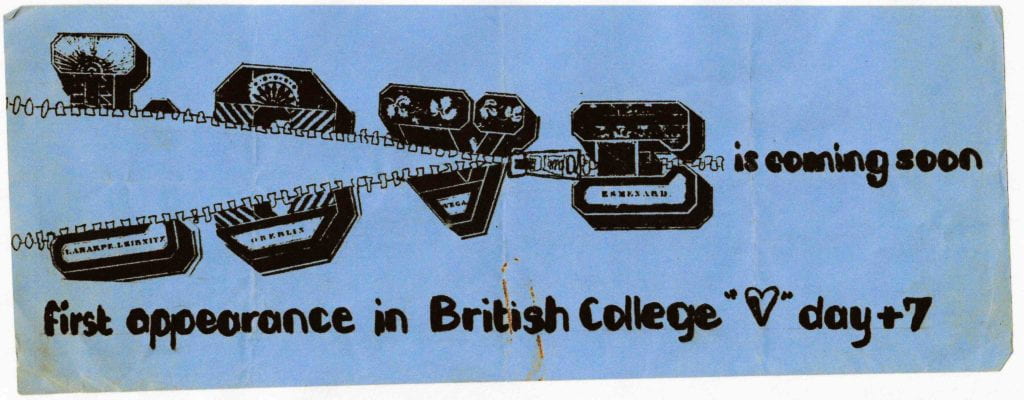
Publicity for LOVE playing at Goldsmiths in 1970. Image: Greg Conway Archive.
It was during the rather appropriately called Goldsmiths’ Valentine’s Ball:
“The West Coast, Rock Band led by Arthur Lee was the main attraction that long ago night and why we went to the event in the first place. They didn’t perform until three in the morning and by then everyone was mellow.
However two impressions of that evening remain – the dimmed lights in the Great Hall packed with students, seated on the floor in groups, most holding lighted candles – magical!
And then the beat of the music reverberating through the wooden floor of the balcony where we were seated; the intensity of it passing through my body so that I thought I would collapse under the force. But of course it took over our senses and emotions and we remained wrapped up in the music until 6.00a.m., when sadly LOVE had to pack up and we wandered off to breakfast.”
The 1960s College circuit played a key role in the development of the music business at this time.
It was an investment in grants for students being given a much wider social access to higher education that funded the national touring of the developing bands and musical artists as well as increasing the demand for albums.
Images of tickets to Goldsmiths’ College gigs donated by Greg Conway. The bottom row, middle ticket is for the first Gold-Dream event held in 1967. Gold-Dream ran over three years with the celebrated seven day ’69 event being the last.
This demand in the UK for qualitative jazz, blues and rock music meant that significant black artists from America such as Muddy Waters, Otis Span and Arthur ‘Big Boy’ Crudup found that they could earn more performing at British universities and colleges and experience bigger audiences than in their own country.
Late 1960s alumni David Mason (an editor of the student union’s weekly newspaper Smith News) and Peter Skinner say their experiences of seeing this music live has always been inspirational:
The first Gold Dream Festival took place in the summer of 1967 and was intended to be ‘a vehicle for displaying the many and varied talents of students in the College, an opportunity for experimentation in certain art forms and an occasion for students and the public to enjoy together certain types of entertainment.’
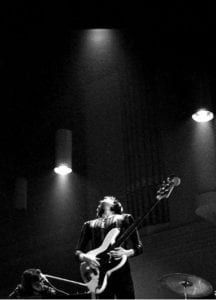
Manfred Mann’s Chapter III in the Great Hall in 1970. Image by Dave Bracher.
In other words ‘Gold Dream’ was supposed to be the College community and the local community partying and celebrating art together. In that first summer the campus rang out to ‘a balloon debate which kicked off to Donizetti’s opera “The Elixir of Love”, a freak-out with the St Louis Union and a poetry reading by Kemble Williams, a Norfolk poet. Drama students found many opportunities for displaying their talents in a review, an experimental improvisation and a workshop production to the theme “Stand Up and Shout No!” A College group put on a music and lights show, there was a Bert Jansch folk concert and and a film showing of ‘Les Carabiniers’ by Jean-Luc Godard.
The idea of turning the Summer Ball into a kind of mini-rock and arts festival was conceived in 1966 under the Student Presidency of John Lauwerys.
After graduating with a B.Ed in 1970, he went on to become Secretary and Registrar of the University of Southampton.
In an interview with alumni magazine Goldlink he said:
“The whole idea seemed so improbable but also so exciting. Why should all night Summer Balls be exclusive to Oxbridge colleges? Why shouldn’t we have such an event at Goldsmiths in New Cross despite not having a river to punt down? That was the proposition put to a General Union Meeting early in 1966 by a wonderfully eccentric student called Hugh Walwyn-James, himself a pure ‘Brideshead’ character. The meeting gave overwhelming support to the proposal without worrying about the possible financial risk to the Students’ Union.”
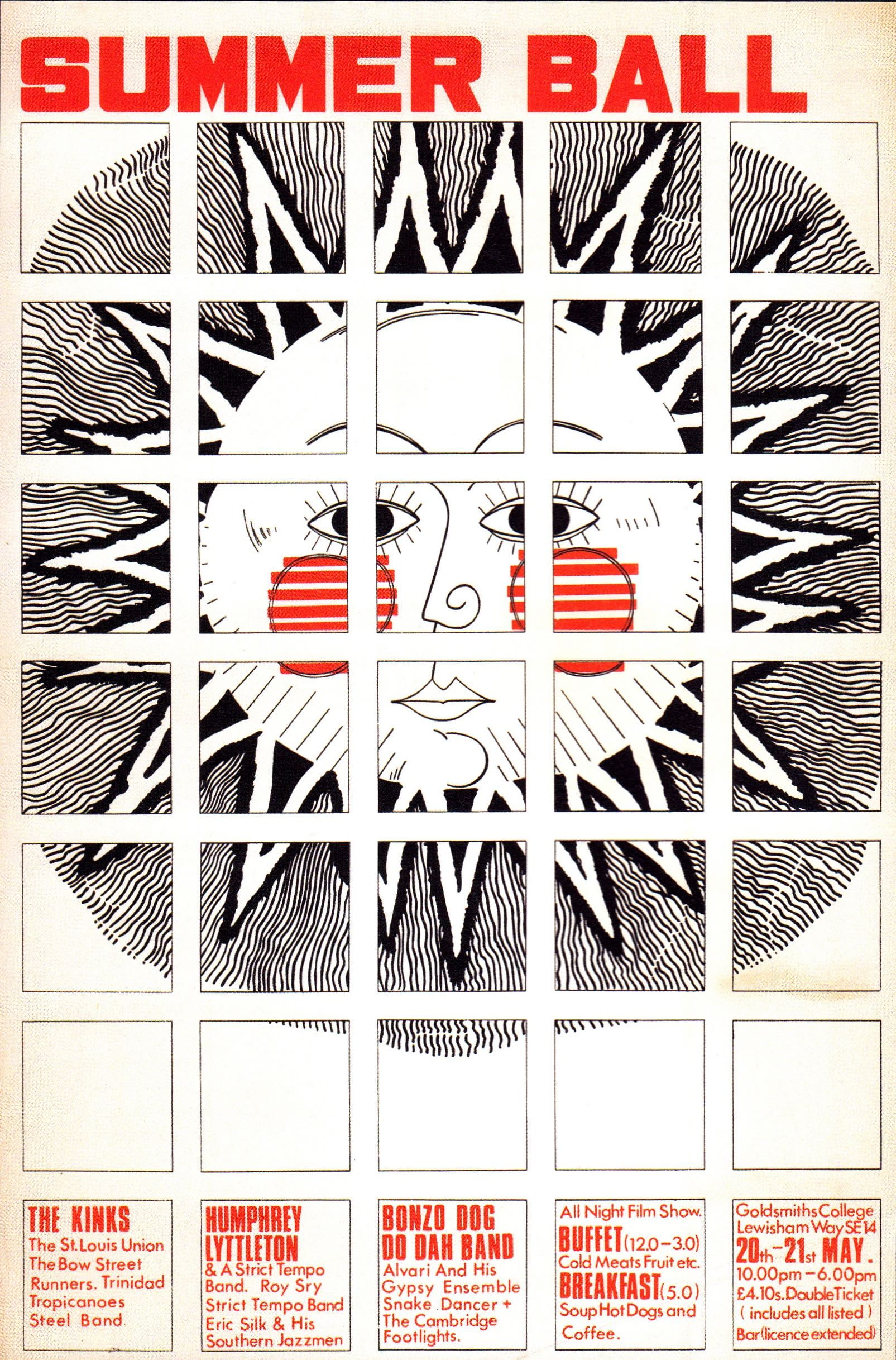
Poster for 1966 Goldsmiths’ College Summer Ball. Image: Goldsmiths Archives.
As can be seen the first Summer Ball negotiated performances from the Kinks, The Bonzo Dog Do-Dah Band (actually formed at New Cross with former Goldsmiths’ art student Neil Innes in the line up) and Humphrey Lyttleton and ‘A Strict Tempo Band.’
This is when the tradition of a gypsy ensemble playing with a snake dancer during the buffet originated.
This was all about ambition and a sense of cultural and artistic optimism.
John wrote:
“The plan was for there to be music playing in parallel throughout the three locations, the Great Hall, the Small Hall, and in the Quadrangle outside the Refectory. In addition there would be a continuous film show of 1920/30s classic comedy films for those in need of a rest! The buffet was to be served at Midnight in the main Refectory with a light breakfast available at 5 am for those who hadn’t flagged out earlier.”
The Summer term at Goldsmiths thus proceeded through the late 1960s with the over-ambitious Summer Ball in May followed by the equally over-ambitious Summer Arts Festival in late June and early July.
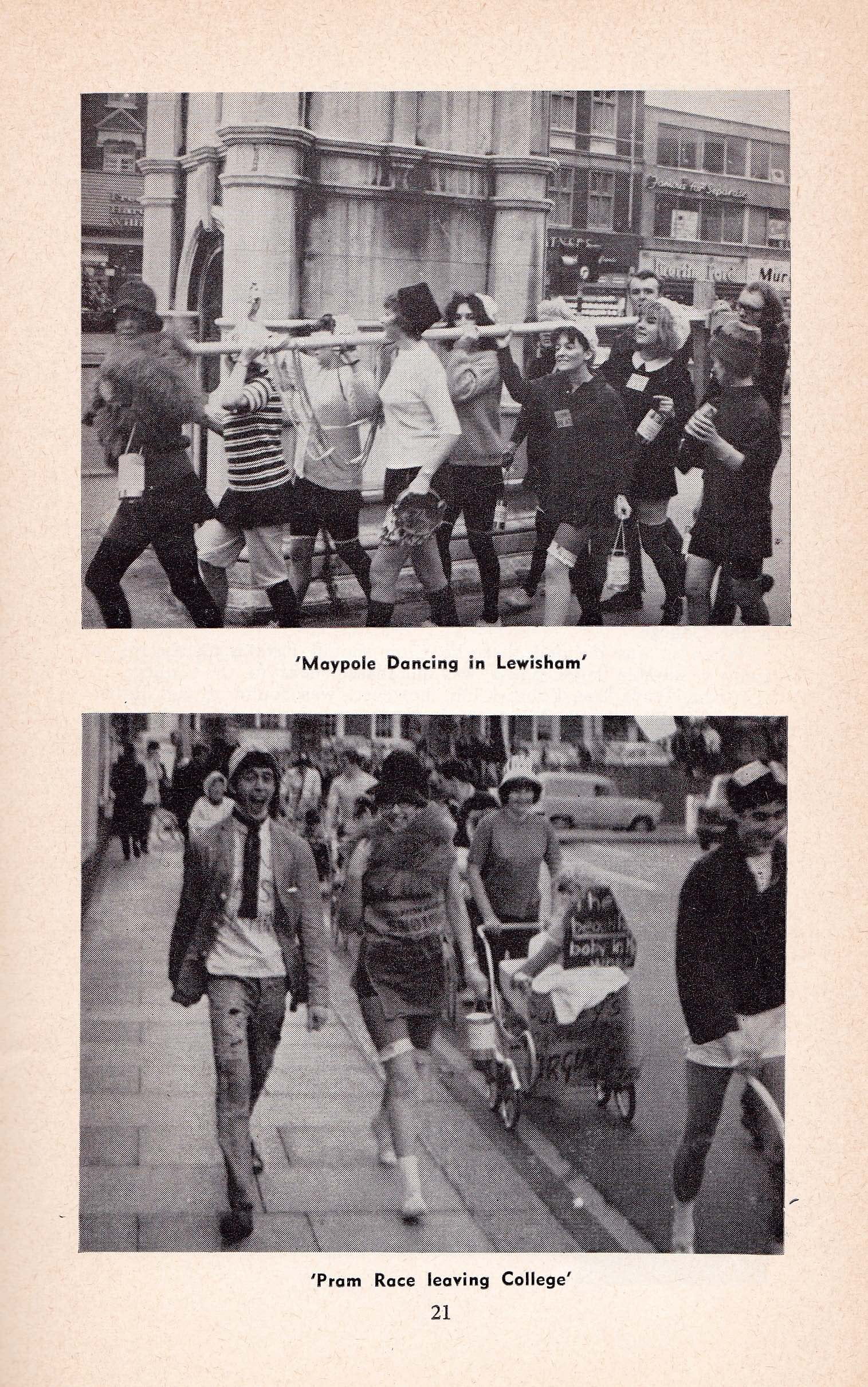
Goldsmiths’ College students in 1967 raising money for charities in ‘Rag’ events. Image: Goldsmiths Archives
Where does this extraordinary spirit of adventure and hope for a better future come from?
Many of Goldsmiths women student alumni offer important explanations.
In a poetic contribution to ‘The Way We Were’ Judy Fawcett asked the question ‘Did the sun always shine?’ and answered with the lines:
“Music, friendship and endless fun.
Every day full of optimism – no money but, … we knew how to dance,
how to laugh, how to love and how to be together.
Biba and Bus Stop gave us style,
Julie Driscoll, Arthur Brown and Bonzo Dogs gave us joy.
[…]
We had dreams, we had ideals,
Life was about caring, principles and passion.
The world was going to be different with our generation – we had discovered – ‘All you need is love.’
We lived ‘Love and Peace’ and we believed education would change the world!”
Julie Driscoll performed ‘Season of the Witch’ in the Great Hall of Goldsmiths in 1968
Maggie Law explained:
“I journeyed from Lancashire to the throbbing, swinging heart of a country in the midst of a huge political, musical and fashionable upheaval to Goldsmiths’ College, which proved an excellent place to be in order to get the best of all that was on offer in this – the best of times. […]
In ’66 it was a group of drama students, staying behind at the end of term, who were co-opted into Antonioni’s “Blow Up”. They can be seen, rather self-consciously cavorting in Maryon Park around the tennis courts, one of them being the famed Anne Webb- What a powerful woman she was.”
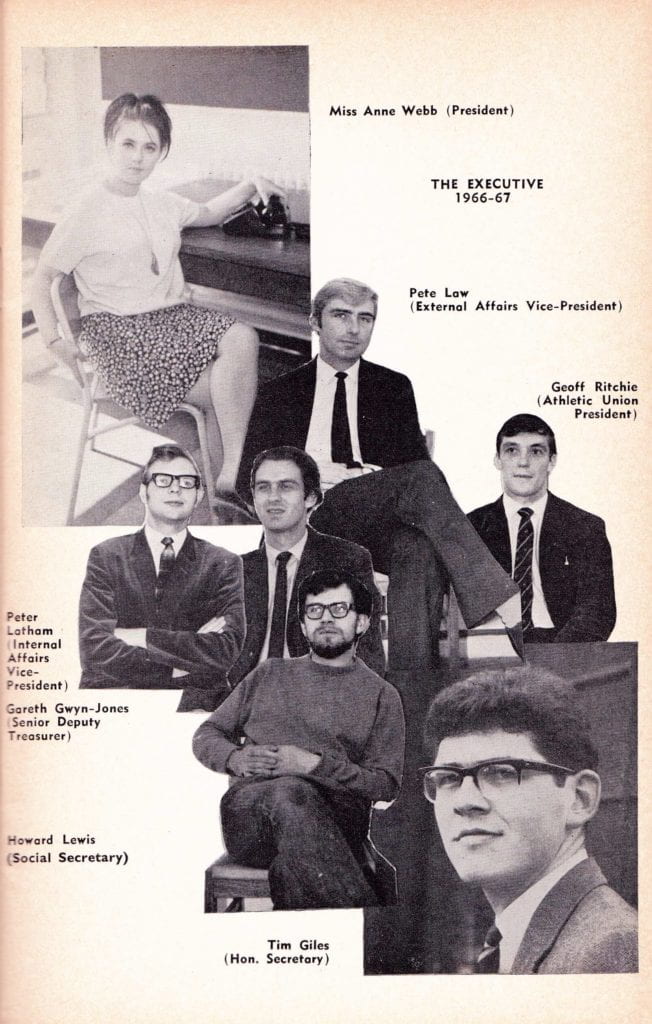
Anne Webb, President of the Goldsmiths Student Union- the first woman in this role in the 1960s leading an executive in 1966-7 consisting of all men in a College where there were more women students. Image: Goldsmiths Archives.
Lizzie Mapson said:
“We knew that there was an energy that permeated everything we did…that nothing seemed impossible…that we were going to change everything because the rule book had been abandoned as we alighted from the New Cross train. […]
But more than all of this, we believed… in each other, ourselves, the power of democracy, the right to protest and be heard, the freedom to love in any way we wanted and in the fact that the world of our parents had endured two world wars and that we would make sure it never happened again.”
Dr Dave Bracher was recording the faces of the people immersed in this social and cultural revolution through documentary photography.
It would not be an exaggeration to say he was a genuine Henri Cartier-Bresson of Goldsmiths’ College.
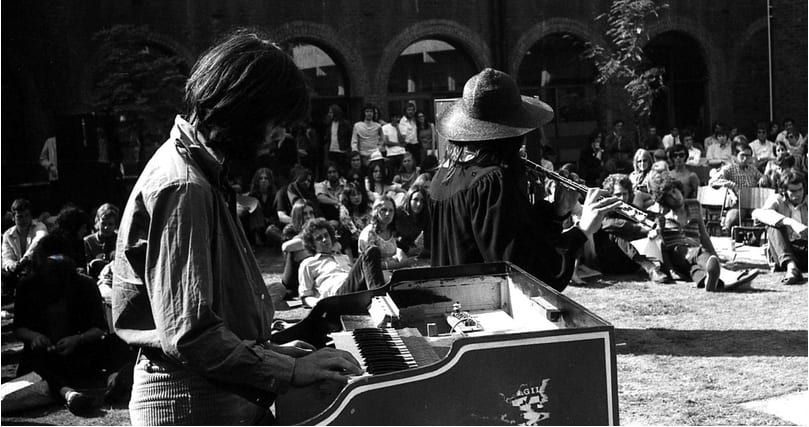
Marsupilami playing the Quadrangle during the Summer Festival of 1969. Image: Dave Bracher
He had been encouraged in the art of photography by his mother who gave him a box camera when a child, and mixing with Goldsmiths’ College Art students gave him an opportunity to find out more about technique and technology.
Russell Profitt became the UK’s first ever Black President of a university student union.
During his year in 1969-70, Goldsmiths’ College students, being in the biggest teacher training institution in the country, led the protests against poor teachers’ pay.
Here is the iconic photograph taken by Dave Bracher of Russell mediating between the students and the police on a day of protest and action starting in New Cross.
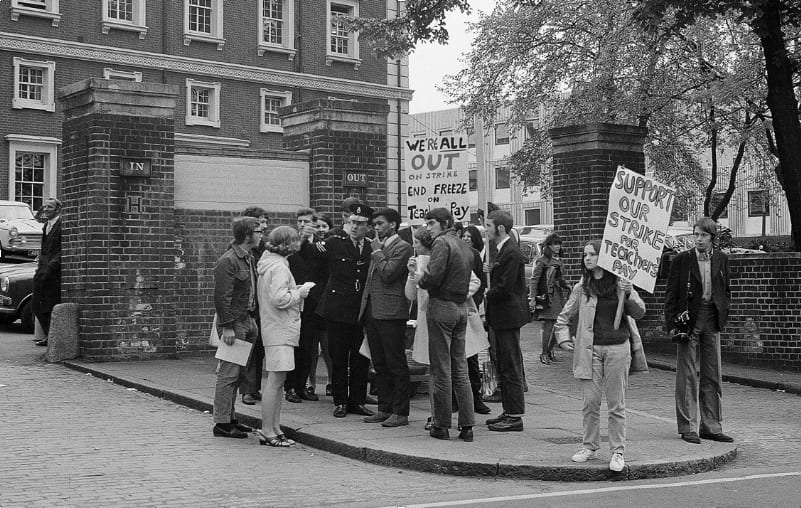
Goldsmiths Student Union President Russell Profitt at the entrance to the College during a student strike against the freezing of teachers’ pay. Image: Dave Bracher.
The late sixties were certainly turbulent in terms of student politics.
Goldsmiths Student Union President Anne Webb wrote at the beginning of the academic year 1967-68:
“There has been a change in the climate of student opinion, probably beginning long before last Easter, but only clearly visible since last October. An increasing demand for student militancy, caused primarily by frustration due to lack of consultation, information and recognition by the University authorities and H.M Government involving in particular the instance at L.S.E. has caught the attention of the press and television. I feel that the lesson to be learned from this is that no group of college administrators or Union officials should become self-satisfied, but should strive to discover the needs of the student body and consult them on major issues.”
In 1967-68 many Goldsmiths students took part in major demonstrations against the Vietnam War; one of them turned into a riot and battle with the police outside the US Embassy in Grosvenor Square.
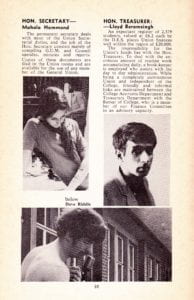
This page from the Goldsmiths Student Union Handbook for 1969-70 depicts Dave Riddle at the 1969 Arts Festival (bottom image) and the Honorary Treasurer reports a student population of 2,379. Image: Goldsmiths Archives.
College Warden Sir Ross Chesterman had to ring up the Commissioner of the Metropolitan Police, Sir Robert Mark, to assure him that his students were law-abiding young people who simply wanted to make the world a better place.
The student union had a Peace Group, as well as a Labour Club, Liberal Society, and Conservative Association.
There was still a tradition of debating with a thriving Debating Society run by Janet Dawson and Lynne Schofield.
Janet observed that Goldsmiths College debating had ‘achieved over the past few years a considerable amount of fame tinged with notoriety amongst other colleges in London and also elsewhere.’
In other words you debated with Goldsmiths’ students at your peril. You had to be good to win your argument.
The academic year in 1967 began with left wing trade union leader Jack Dash addressing about 300 students on a disruptive and controversial Dock dispute.
The Society ran an Inter-Hall debating competition on the proposition ‘American political friendship is the kiss of death.’
Malcolm Edwards (later known as McLaren) led a Maoist and Situationist approach to politics from the College’s Art School which had its own ‘School of Art Union.’
This decried debating and advocated ‘direct action’- something Russell Profitt was to experience during his presidency in 1969-70.
The issue of food is something of a perennial one in the history of Goldsmiths.
There were food strikes before the First World War.
Student union handbooks through the 1960s allocated a page to advise those new students not particularly enamoured of ‘the prospect of living in New Cross for three years or maybe more.’
Student Philip Hotton observed:
“New Cross has an abundant supply of pubs: The New Cross House offers friendly service and extremely good sandwiches and rolls; this is situated about one hundred yards from College. One hundred yards in the other direction is the Rosemary Branch which also offers snacks.”
Not a lot on offer for a palate that wants more from life than English sandwiches and rolls and a few 1960s pub snacks, or indeed Blackburn’s Fish Bar, or Burrough’s Eel & Pie Shop.
John Lauwerys offered a guide for ‘The Gourmet On A Shoe String’ in 1966-67.
He also warned the new student that in his opinion there was only ‘one restaurant in South East London that can measure up to the high standards of the average Soho ones.’
Not a lot was recommended on offer at the Roma Grill- described as ‘Italian, pleasant decor’ and only good for a steak.
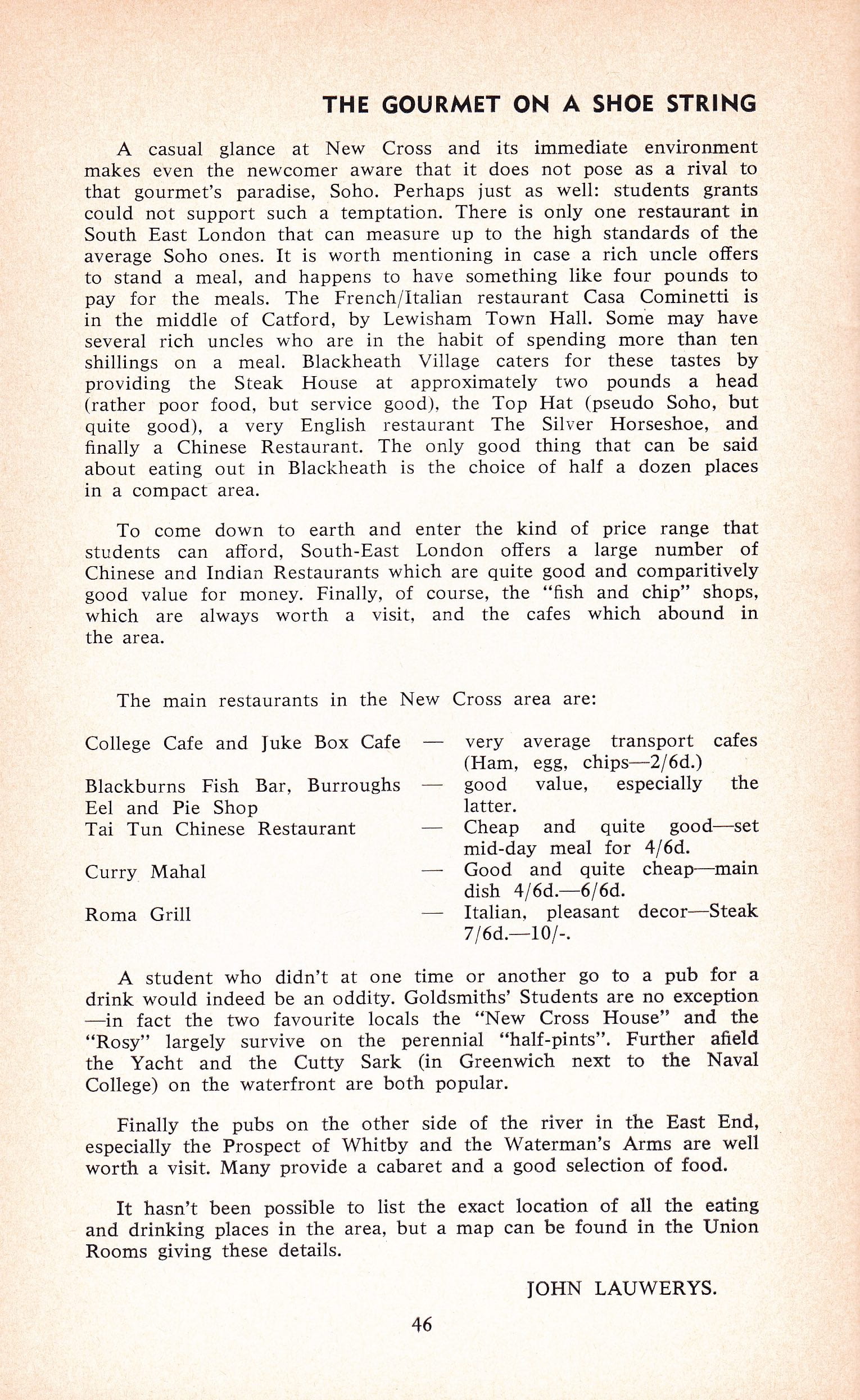
Goldsmiths alumni David Swarbrick had a distinguished career in teaching spanning more than three decades after graduating from Goldsmiths with a degree in 1972.
The College food and militant politics were not particularly his thing, but the music, entertainment and culture certainly were.
It was student union social secretaries in the years 1967 to 1970 who bore the main brunt and responsibility for booking the big acts that put Goldsmiths’ College on the map in regard to the university musical circuit.
They were Greg Conway, John Glockler, and Dave Riddle. Sadly John Glockler passed away in 2016.
His friend and fellow band player, Dave Mason (yes, Goldsmiths students from this time formed their own bands and performed as support acts to the famous groups playing at the College) paid tribute to the significance of John Glockler’s contribution:
“He was the second of three brilliant and imaginative Goldsmiths Student Union Social Secretaries who covered the period 1967-1970, the others being Greg Conway (1967-68) and Dave Riddle (1969-70). In 1967 the music industry, led by Chris Wright and Terry Ellis (who later founded Chrysalis Records), turned towards the university and college circuit as a more lucrative market for their performers. Greg, John and Dave seized this opportunity to provide Goldsmiths students with the biggest and the best of bands. In total they booked more than 150 acts, giving us a musical legacy it is difficult to forget and Goldsmiths College a reputation as a place to hear the best in music.
Here is a small selection from the acts that John, Greg and Dave booked – 1967 to 1970
• Cream, Led Zeppelin, Deep Purple, Moody Blues, Traffic, Jethro Tull, Hawkwind, King Crimson, Love.
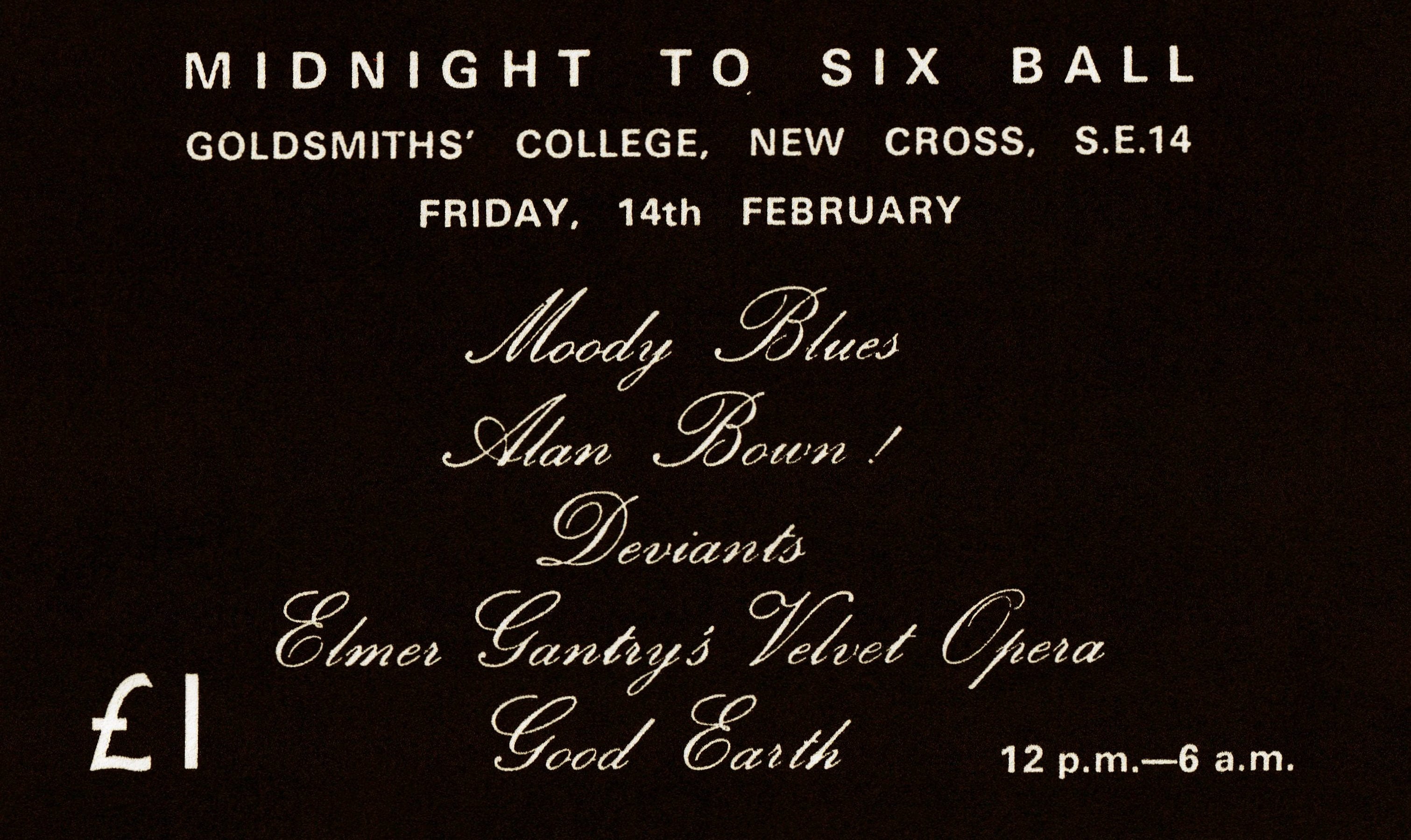
Original ticket invitation. Image: Greg Conway.
• Pentangle, Bert Jansch, John Martyn, Gordon Giltrap, John Renbourne
• Judy Collins, Julie Driscoll with Brian Auger & The Trinity, Christine McVie with Chicken Shack.
• Georgie Fame, Yardbirds, Chris Farlow, Pretty Things, Joe Cocker and the Grease Band
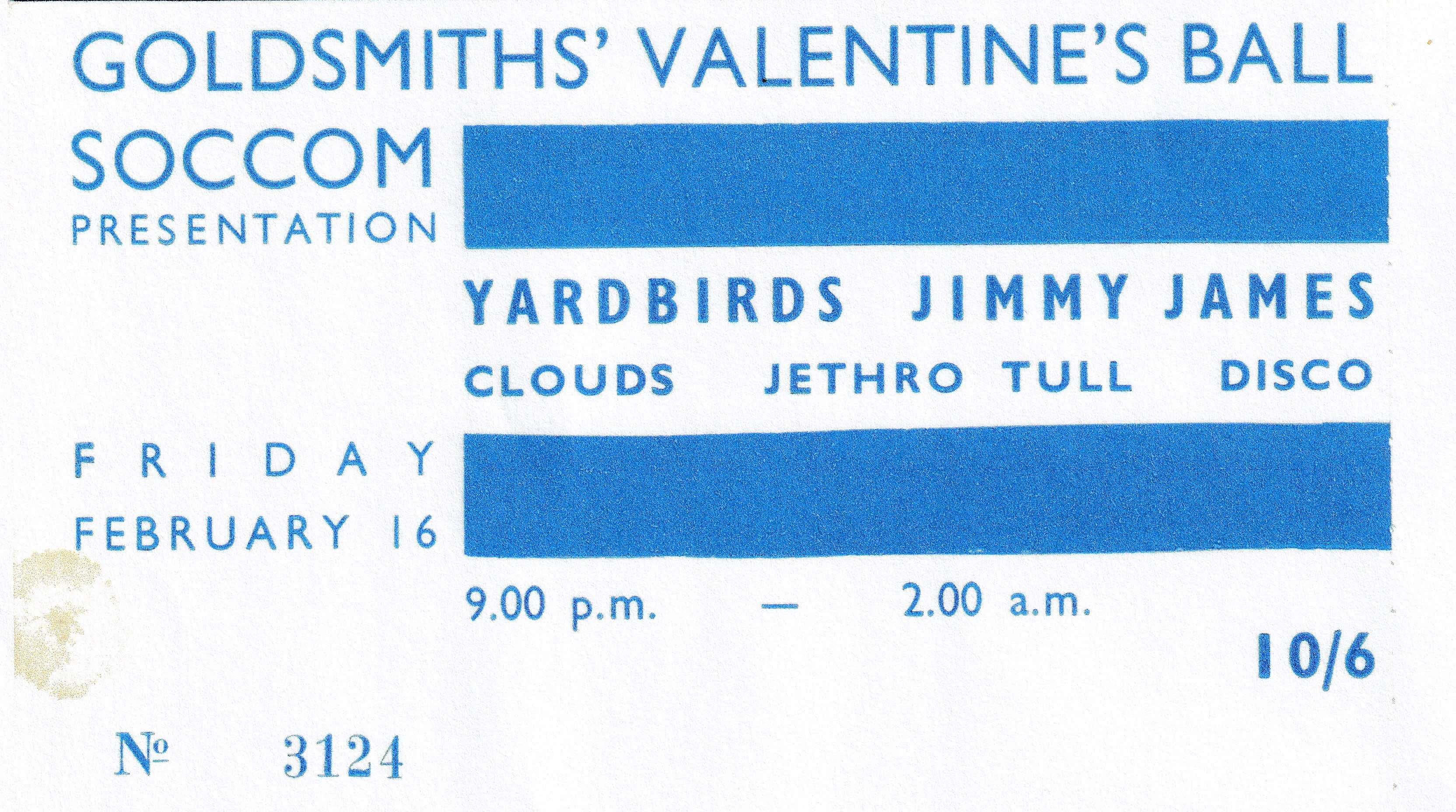
Original ticket invitation. Image: Greg Conway.
• Ambrose Slade (renamed later as Slade), Atomic Rooster, East of Eden
• The Bonzo Dog Doo-Dah Band, the Crazy World of Arthur Brown, Liverpool Scene, Scaffold
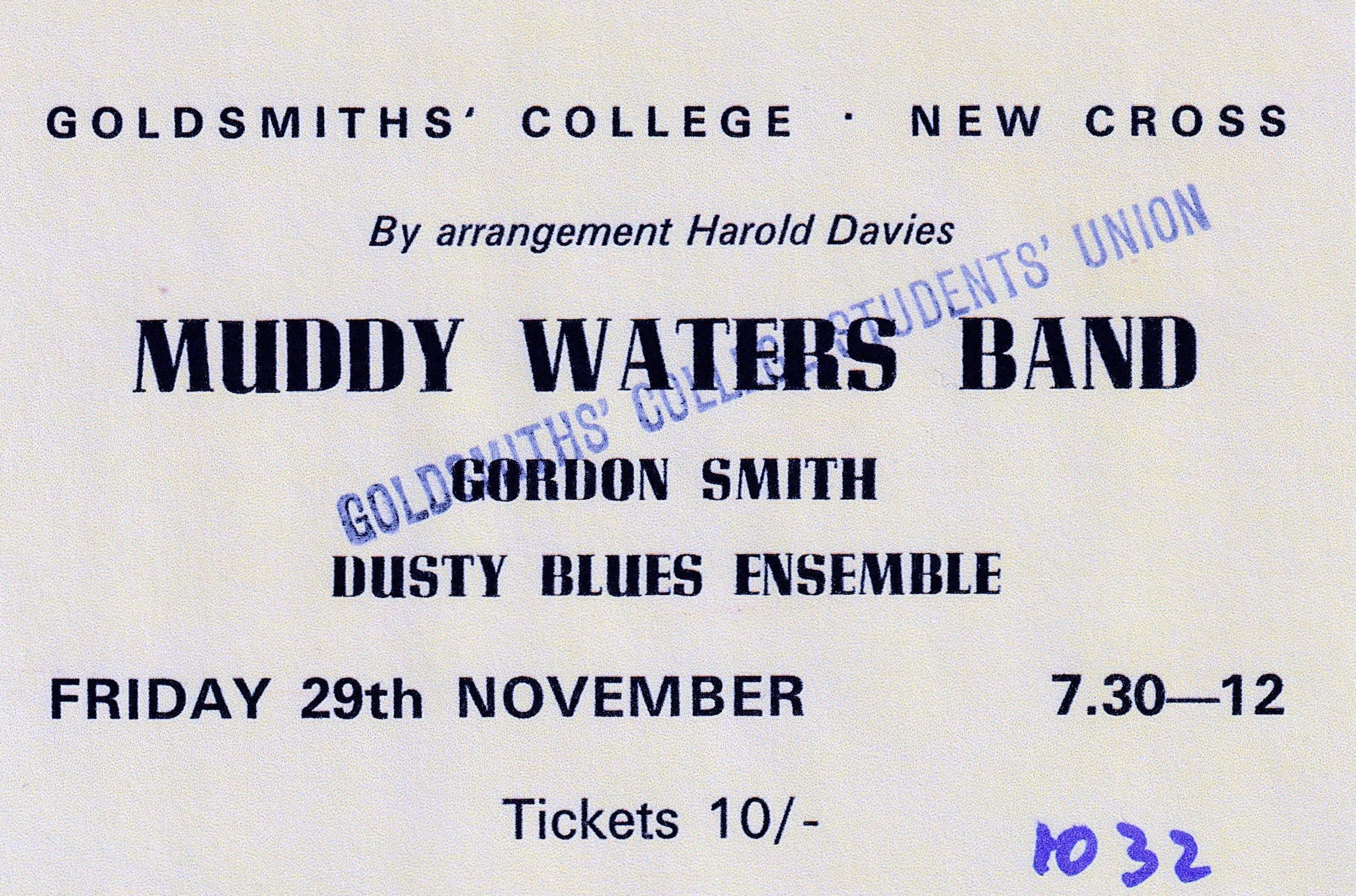
Original ticket invitation. Image: Greg Conway.
• Muddy Waters, Arthur ‘Big Boy’ Crudup.
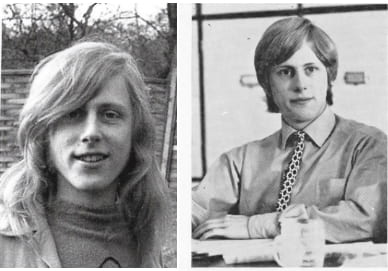
John Glockler (1944-2016), Goldsmiths College Student Union Social Secretary 1968-69.
Dave Mason speculates that it may well have been the intersection of John Glockler’s musical talent and originality and Malcom Edwards/McLaren’s presence at Goldsmiths that was the spark that catalysed Punk:
“In 1969 John formed a rock’n’roll group, aptly named Johnny Rock and the Prowlers. John as Johnny Rock on vocals, Julian Bailey on lead guitar, Alan Hales on bass, David Mason on piano and Frank Kelly on drums. When John Glockler took on the Johnny Rock persona, it was a Jekyll and Hyde transformation. This quiet and modest man delivered every number with a unique style of a-tonal screaming aggression, spitting out each word at the audience in an anarcho-punk style that predated Johnny Rotten and the Sex Pistols by almost a decade. Johnny Rock and the Prowlers performed at the Goldsmiths Arts Festival in 1969. One of the Festival organisers was Malcolm Edwards, later known as Malcolm McLaren. He must have seen John perform. Is it too much to claim a causal link between Johnny Rock and Johnny Rotten?”
In 1967-68, Social Secretary Greg Conway was organising a ‘Gold Freak Out Dance’ before the Gold Dream Festival.
He and his father installed a Vox 50 Watt amplifier, two 15 Watt Fane speakers, and two Gerrard SRP 22 record decks for the discotheque infrastructure in the Small Hall.
He had donated his copy of Student Union minutes from December 1967 in which he reported that:
“It was obvious at the Flower Inferno that large numbers of people were entering College without tickets, particularly via the windows of the Small Hall and T.V. Room.”
The Social Secretaries had to run a complicated business where large-scale events needed to break even, and if possible make a profit through ticket sales.
Greg remembers that the allure of the riches on offer from the Summer Balls and Arts Festivals was a significant attraction to prospective students visiting the College when deciding on their choices for University and teacher training.
In 1968, those looking around the College were given the following notice:
“This is the first time we have ever given you, a prospective Goldsmiths’ student, the chance to attend the major function of our social calendar- The Summer Ball.
You will see Goldsmiths’ and meet your fellow students and have the experience of a lifetime.
Come to Summer Ball and Hear:
TRAFFIC
BONZO DOG DOO-DAH BAND
THE SPINNERS
At last the 1958 Rock’n’Roll Show, Honneybus: Episide Six; Chicken Shack; Trevor Hall Band; The Cherry Pickers; Mexican Troupo; Limbo
BUFFET and BREAKFAST.”
Greg recalled that the Goldsmiths’ College creative and inspirational environment encouraged him to do things he does not think he would ever have done at another university.
He designed three covers for the Student Union weekly newspaper Smith News.
The Goldsmiths Golddream Exhibition has been curated by Dr. John Price (Head of History Department) Public Engagement executive Will Cenci, Director of Estates & Facilities Vivienne Rose, former Goldsmiths student and member of staff Dave Riddle, Dr David Bracher, and Goldsmiths Historian Professor Tim Crook.
Click on the link above to book your place or click through on the image below.
Goldsmiths, University of London thanks everyone who has given their time, memories, and memorabilia to make the exhibition and this historical online feature possible.
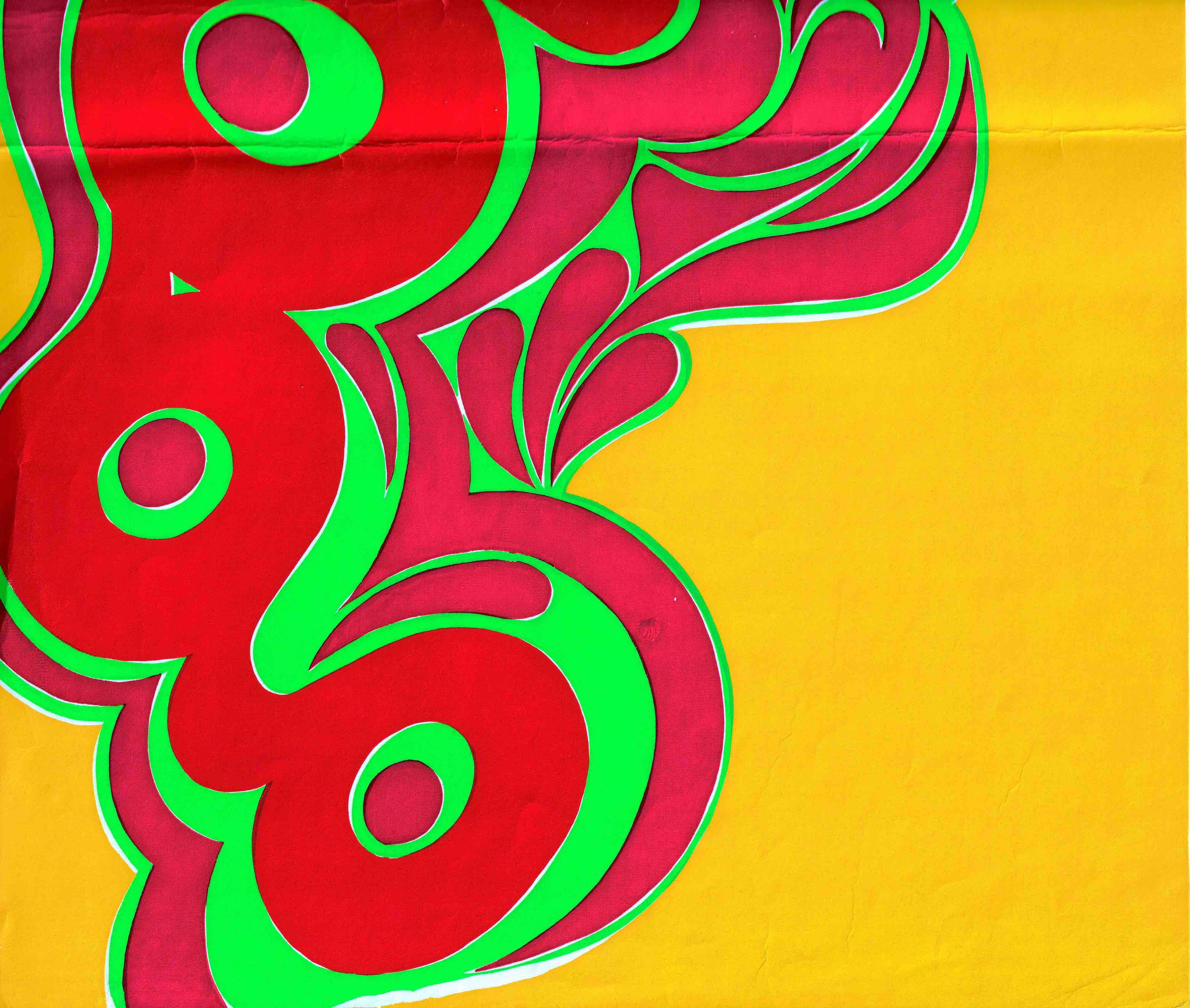
Lower section of iconic Golddream poster for the Goldsmiths’ College Free Arts Festival donated to the university archive by Greg Conway.
That’s So Goldsmiths– a forthcoming history of the university is being researched and written by Professor Tim Crook.
